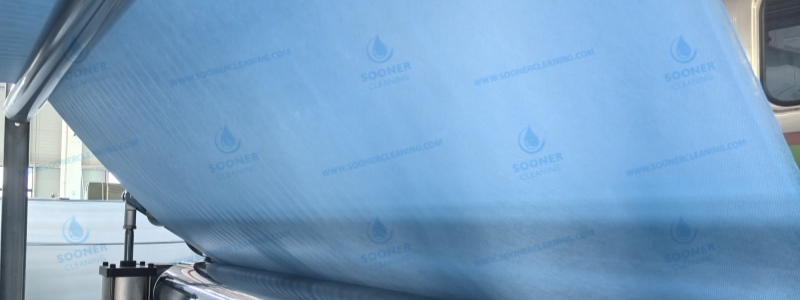Home>News
Spunlace nonwoven finishing technology
- 2024-08-09
Finishing technology plays an indispensable role in improving the performance of spunlace nonwoven materials and is a key step in developing high-performance, differentiated spunlace wiping materials. Common nonwoven finishing technologies include padding, coating, dyeing, calendering, soft finishing and hydrophilic finishing.
For spunlace wiping materials, according to different application fields and use environments, the performance that needs to be improved through finishing is also different. Generally, the antibacterial property, hydrophilicity and lipophilicity, antistatic property, high temperature resistance, wear resistance, water repellency, etc. of the spunlace nonwoven product can be improved through finishing. In the previous article, we summarized several existing spunlace nonwoven technologies on the market. Now let's talk about what finishing technologies are available for spunlace nonwovens.

Spunlace nonwoven antibacterial finishing technology
Currently, the antibacterial agents used for spunlace antibacterial finishing are mainly natural antibacterial agents, inorganic antibacterial agents, and organic antibacterial agents. Generally, the antibacterial agent is attached to the fiber surface through simple padding, spraying or coating processes.
Traditional antibacterial finishing technology sprays the prepared AgNPs on polyester/viscose spunlace nonwoven materials to prepare antibacterial spunlace wipe materials, but the antibacterial properties obtained by this method are short-lived and there is a risk of volatilization of the antibacterial agent. Therefore, in recent years, the research on antibacterial finishing of Soonercleaning has mainly focused on the improvement of antibacterial agents. The spunlace wipe material using c-OPE-Im antibacterial agent has an excellent sterilization effect on Escherichia coli after 5-10 minutes of light exposure, and exhibits strong antiviral properties. The SARS-CoV-2 virus can be completely inactivated within 20-30 minutes of light exposure.
Hydrophilic and lipophilic spunlace nonwoven material finishing technology
Spunlace cleaning wipe materials generally need to rely on hydrophilicity and lipophilicity to load cleaning liquids and absorb stains. At present, the main methods of hydrophilic and lipophilic finishing are coating finishing agents and chemical grafting modification. The kitchen-specific degreasing wiping material developed by Soonercleaning is a spunlace nonwoven material that has good degreasing performance by impregnating it with a special liquid. The degreasing rate of the liquid can reach 60.8%. The product has a small environmental burden, no odor, and is non-irritating. In addition, Soonercleaning spunlace nonwoven uses a photoinitiator, a hydrophilic grafting monomer, and a lipophilic grafting monomer to perform hydrophilic and lipophilic finishing on PET/PA6 bicomponent spunbond spunlace nonwoven materials by ultraviolet light grafting. When the grafting rate reaches 18.32%, the water absorption rate of the product increases by 39.25%, and the oil absorption rate increases by 73.58%, which is of great significance for the application and promotion of kitchen wiping materials.
Antistatic finishing technology of spunlace nonwoven materials
The antistatic finishing of spunlace nonwoven materials mainly combines antistatic agents or hydrophilic groups with the fiber surface through chemical grafting polymerization, adsorption of additives, and ion treatment to improve the antistatic durability of spunlace nonwoven fabrics. As a professional spunlace nonwoven supplier, Soonercleaning's R&D team cross-links the resin antistatic agent with active groups with the surface of the fiber mesh to make the fiber surface tightly bonded to form a lasting antistatic effect. The surface resistance of the prepared spunlace wiping material is 108Ω~109Ω, which meets the antistatic demand during dust-free wiping.
High temperature resistant finishing of spunlace nonwoven materials
Soonercleaning's high temperature resistant finishing of spunlace nonwoven materials mainly uses spraying, mixing and other methods to make the heat-resistant materials adhere and wrap on the fiber surface, thereby playing a role in heat insulation. Aerogel is mixed into spunlace nonwoven materials and burned through a flame hand system, which effectively improves the heat insulation and high temperature resistance of spunlace nonwoven materials.
If you want to know more about spunlace nonwoven fabric, please contact us. Soonercleaning provides you with customized solutions and free samples.
E-mail: info@soonercleaning.com
Skype: +86 13810146753



